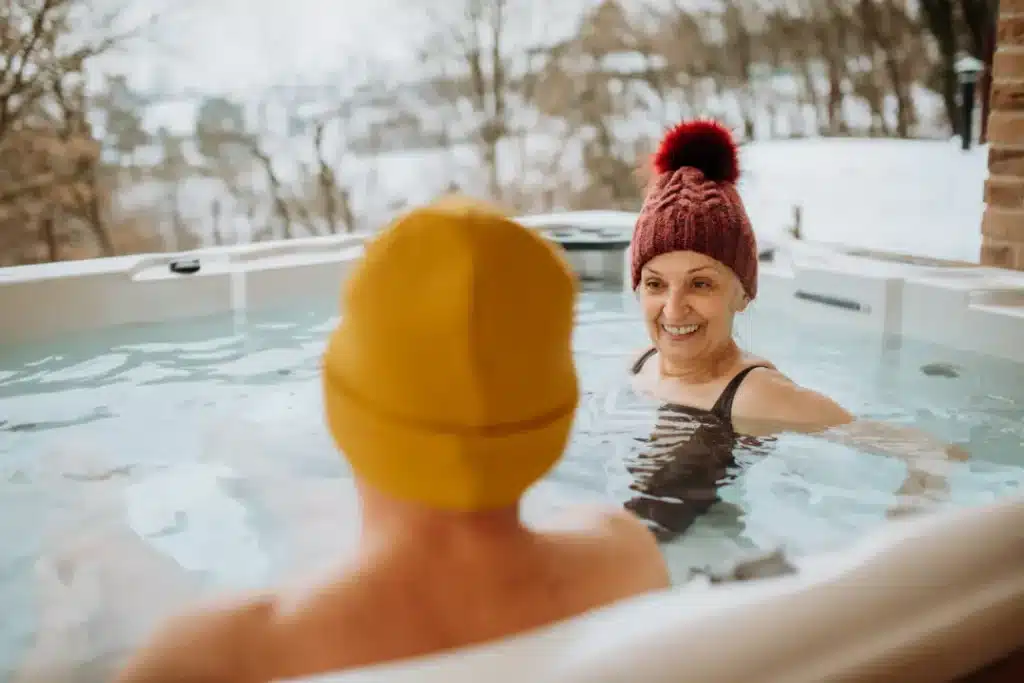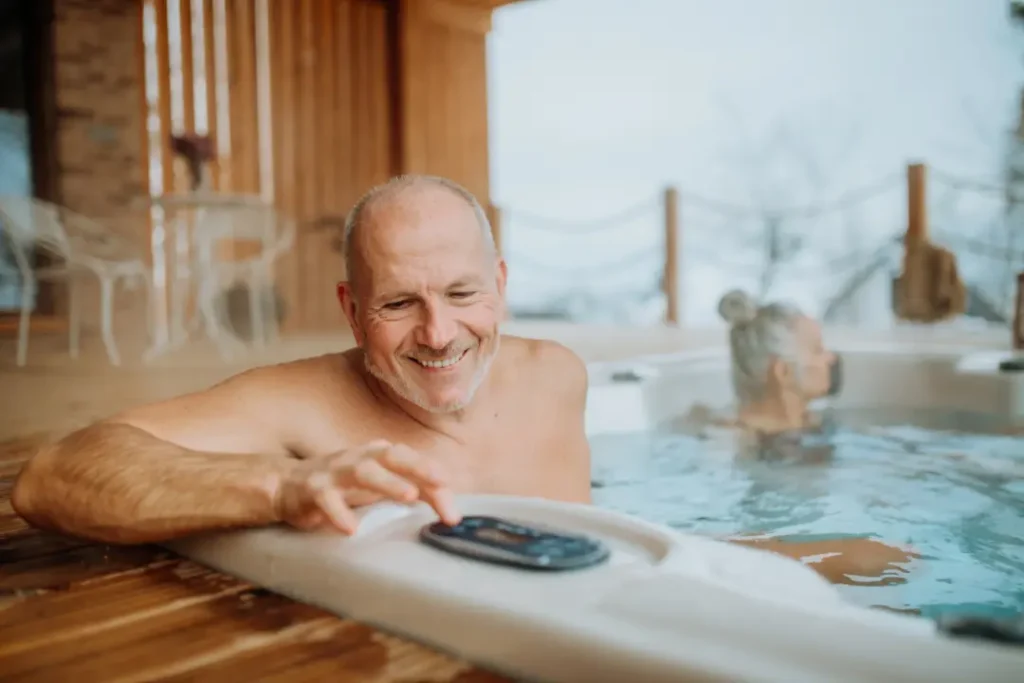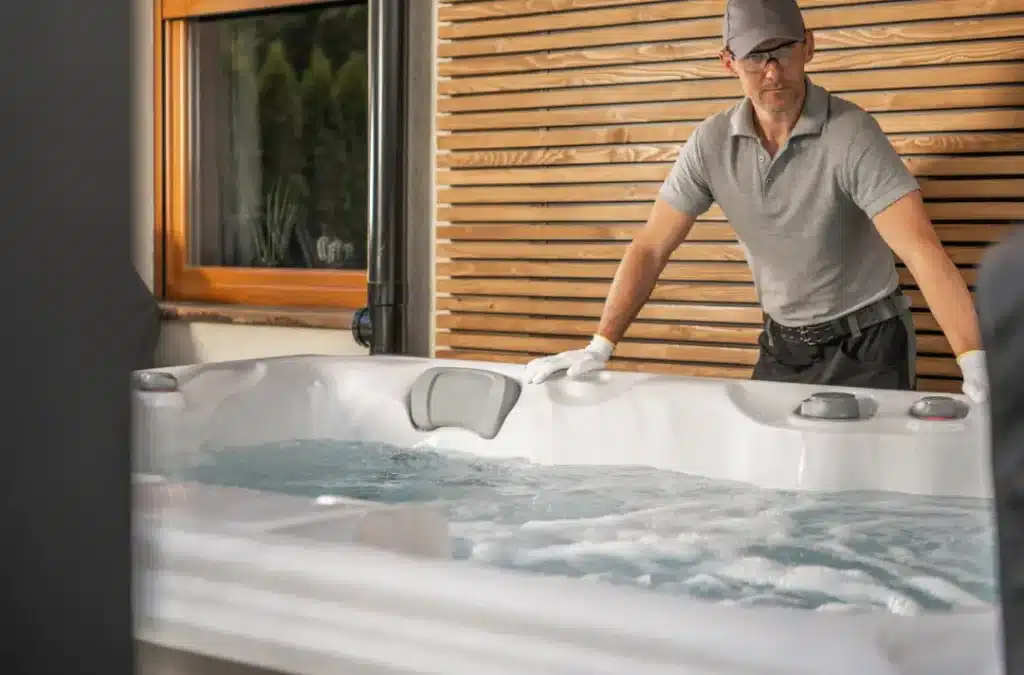Finding the perfect hot tub temperature is essential for a relaxing and safe experience. The ideal temperature typically ranges between 100°F and 102°F, balancing comfort and safety.
This article delves into recommended temperature ranges, factors influencing these temperatures, and how to keep everyone safe and comfortable year-round.
Key Takeaways
- The ideal hot tub temperature for comfort and safety typically ranges between 100°F and 102°F, with special considerations for children and pregnant women.
- Seasonal adjustments are important for maintaining comfort and energy efficiency; higher temperatures are recommended in winter, while cooler settings are preferable during summer.
- Regular maintenance and monitoring of hot tub temperature is crucial for safety and optimal performance, with a focus on preventing overheating and ensuring water quality.
Understanding Ideal Hot Tub Temperature
Soaking in a hot tub should be a pleasurable experience where relaxation meets safety. The right temperature enhances relaxation and provides health benefits, such as improved blood circulation and stress relief. Balancing comfort with safety ensures an enjoyable and secure hot tub experience.
The ideal hot tub temperature varies with the season and weather. Adjusting the temperature for a chilly winter evening or a warm summer day can significantly enhance your experience.

Recommended Temperature Range
Most hot tubs are comfortable between 100°F and 102°F. While some prefer a lower setting around 98°F, others may enjoy temperatures up to 104°F. The standard maximum temperature is 104°F, and exceeding this can pose heat-related health risks. Adhering to these guidelines is crucial for a relaxing experience.
Special Considerations:
- Children: For children over five, a temperature of 95°F is recommended. This helps prevent overheating and ensures safety while they enjoy the warm water.
- Pregnant Women: The perfect temperature for pregnant women should be limited to 102°F or lower to avoid potential health risks. Consulting with a doctor before using a hot tub is advised.
- Health Conditions: Individuals with cardiovascular, respiratory, or cerebral conditions should use lower temperatures. Prolonged exposure to extremely hot or cold water can exacerbate these issues, so consulting a medical professional before use is essential.
Factors Influencing Ideal Temperature
Several factors influence the ideal hot tub temperature, including personal preferences, age, and health conditions. Some prefer a hotter soak for muscle tension relief, while others find lower temperatures more comfortable due to sensitive skin or health concerns.
Also, environmental factors like climate and season affect hot tub settings. Cold air can cause rapid temperature drops, requiring adjustments to maintain comfort. Considering these factors helps tailor the water temperature to individual needs.
Safe Hot Tub Temperatures for Different Users
Safe hot tub temperatures are crucial. Children, pregnant women, and those with health conditions need special attention to avoid adverse effects. Maintaining a safe hot tub temperature is essential for everyone’s safety.
Age and health influence safe temperature zones. Regularly checking and adjusting water temperature based on user numbers and activity levels ensures a safe and enjoyable experience.
Children
Children are more susceptible to overheating, so maintaining safe temperatures is crucial. Their recommended hot tub temperature should not exceed 100°F (37.8°C).
This precaution helps prevent overheating and ensures their safety while enjoying the warm water and hot water.
Pregnant Women
Pregnant women should be cautious when using hot tubs. Consulting a doctor is highly recommended. To avoid health risks like fetal damage, they should limit temperatures to 100°F (37.8°C) and avoid going above 102°F.
People with Health Conditions
Individuals with cardiovascular, respiratory, or cerebral conditions should be cautious with hot tub use. Prolonged exposure to high temperatures can exacerbate these issues, so lower temperatures are often recommended for those with heart problems.
The ideal temperature for those with health concerns varies by medical history and condition. Consulting a medical professional before use ensures personalized and safe hot tub experiences.
Seasonal Adjustments for Hot Tub Temperature
Adjusting hot tub temperatures according to the season helps maintain comfort and energy efficiency. Proper adjustments enhance the overall experience and reduce energy consumption.
- Winter Settings: During winter, a temperature of 100°F (38°C) is recommended for a warm soak. Some users may prefer setting their hot tubs to the maximum safe limit of 104°F to retain heat. Keeping the cover on when not in use helps maintain the temperature.
- Summer Settings: In summer, a temperature range of 29°C to 35°C (84°F to 95°F) offers a refreshing experience. Lowering the temperature to 95°F or below helps prevent overheating and ensures comfort. In hotter climates, even lower temperatures may be necessary to avoid heat stroke.

Maintaining the Right Hot Tub Temperature
Regular maintenance is essential to keep your hot tub in optimal condition and ensure consistent temperature. This includes water testing, chemical balancing, and filter cleaning. Modern hot tubs feature improved insulation and energy-efficient components, enhancing heating times and reducing costs.
Maintenance Tips:
- Control Panel: Use the control panel to regulate the temperature and make incremental adjustments of 1-2°C to avoid stressing the heating system. To quickly cool the water, lower the temperature on the control panel and turn on the jets.
- Energy Efficiency: Use a quality insulated cover to retain heat and minimize energy loss. Regularly check insulation and secure the cover to improve heating performance and efficiency. Adding insulation around the hot tub can further reduce temperature loss.
Heating Time and Efficiency
Heating times vary from 3 to 8 hours, depending on the initial water temperature and hot tub size. Larger hot tubs may take longer to reach the desired temperature. Understanding these variables helps you plan your hot tub sessions better.
Tips for Faster Heating
Use a thermal cover when not in use to retain heat and speed up heating times. Reduce hot tub heater settings when the hot tub is not in use to conserve energy and lower heating times.
Safety Considerations
Safety is paramount when using a hot tub. Incorrect temperatures can cause hypothermia or hyperthermia. Individuals with health conditions should consult a medical professional before use. Regularly monitoring and adjusting water temperature helps prevent overheating and ensures safety.
Stay hydrated while using a hot tub to reduce health risks. Always supervise children in and around hot tubs to prevent accidents. The maximum allowable average body temperature for hot tub use is 102°F (39°C). In cold climates, the maximum safe temperature is 106°F.
Discover Unmatched Excellence with Action Spa Repair
At Action Spa Repair, we offer unparalleled expertise in hot tub maintenance and repair, ensuring your relaxation space remains in peak condition. With over 30 years of experience, our team of fully licensed and insured professionals provides swift, reliable service for all hot tub brands.
From precise diagnostics and comprehensive repairs to regular maintenance packages, we are committed to enhancing your hot tub experience with minimal downtime and maximum satisfaction. Choosing Action Spa Repair means investing in quality and peace of mind.
Our commitment to thorough, personalized service means that each repair and maintenance task is handled with the utmost care and attention to detail. By opting for our services, you benefit from our extensive industry knowledge and top-notch customer support, ensuring your hot tub operates efficiently and safely year-round. Enjoy the confidence that comes with knowing your hot tub is maintained by seasoned experts dedicated to your comfort and safety.

Frequently Asked Questions
What is the recommended hot tub temperature for general use?
The ideal hot tub temperature for general use is between 100°F and 102°F, giving you that perfect balance of comfort and relaxation. Enjoy your soak!
Can children safely use hot tubs?
Absolutely, children can enjoy hot tubs, but make sure the spa temperature stays below 100°F (37.8°C) to keep them safe and prevent any overheating.
What temperature should pregnant women set their hot tub to?
Pregnant hot tub owners should keep their hot tub at a maximum temperature of 100°F (37.8°C) to ensure safety. Staying below this limit helps reduce potential health risks for both mom and baby.
What services does Action Spa Repair offer for hot tub maintenance?
Action Spa Repair provides detailed diagnostics and comprehensive repair solutions to keep your hot tub in top shape. You can count on us to ensure your spa lasts longer and performs better!
Conclusion
Maintaining the ideal hot tub water temperature is crucial for maximizing your relaxation and ensuring safety. By understanding the recommended temperature ranges and adjusting for seasonal changes, you can enjoy a consistently comfortable soak. Regular maintenance and prompt repairs are key to keeping your hot tub in optimal condition and extending its lifespan.
With Action Spa Repair’s expert services, you can rest assured that your hot tub will be well cared for, allowing you to fully enjoy the benefits of your investment.
Our dedication to quality and customer satisfaction ensures a superior hot tub experience, making us the ideal choice for all your hot tub maintenance and repair needs.
